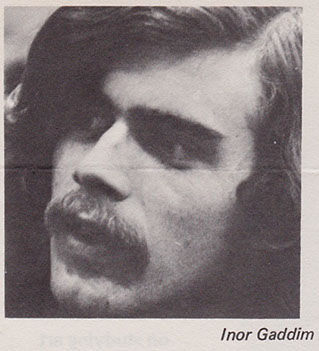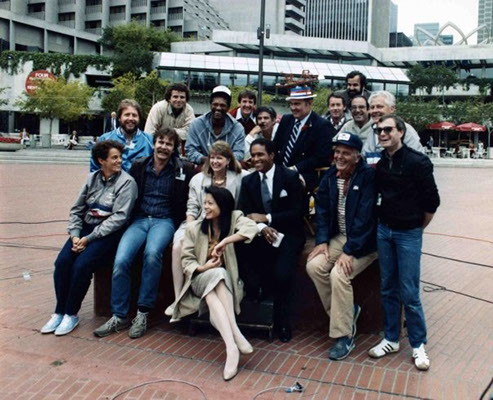













Above: Ron seated next to Jane Pauly and Bryan Gumble along with the rest of the cast and crew of the Today show.

After a couple of months on the air at KPRI, things started to happen. We started getting mail from listeners. People liked what we were doing and they wanted us to start earlier than midnight. It took some hard convincing, but after a time we talked Larry the manager into letting us start at ten o’clock. Then it became eight o’clock. At the same time, a local surf shop inquired about buying advertising. The Larry offered the best early afternoon times but George's Surf Shop wanted his spots on at night when the rock music was being played. The Surf Shop and the Paisley Pelican were the first of a lot of local advertisers that wanted to have their commercials on the rock & roll KPRI.
During all this time the station had been up for sale and eventually was purchased by Southwestern Broadcasters. During the six months while the sale was being completed, we continued playing more and more of the rock until finally we were on the air twenty-four hours a day with it.
There were still only three disc jockeys working in eight-hour shifts, 0. B. Jetty, Acmad the Revolving, and Inor. We still maintained other jobs, Steve in the Navy, Acmad as a night watchman, and I was working at a new TV station. The schedule was a little hectic to say the least. We went through our share of growing pains, but on the whole, I guess things went pretty well. We began to stretch out in this new approach to radio and play not only rock music but some jazz and comedy as well.
To this point the approach on the air was totally free form and there was very little structure to the format. It was loose and about as personal a brand of radio as I had ever heard. The jocks pretty much projected their own real personalities.
In June of 1968, just before we made the move to our new studio, the Navy saw fit to send Steve to Vietnam. This was when I became Program director and got involved in the web of intrigue.
In July of 1968 a lot of things happened. For the first time we showed up on a Pulse rating. It was during this time that some of the larger advertisers started looking at us more seriously. Also in July, we moved from the basement of the drug store to larger quarters at 7th & Ash and acquired a couple of more jocks and started actually getting paid.
During the summer months, the ratings continued to get better and things generally went well. We began to get a little more involved with the community and take a stand on important issues. For a while we even had the Mayor of San Diego on the radio one day a week where we confronted him with questions about some of the issues that seemed important to us.
In spite of the good ratings and general listener acceptance, the sales department seemed to have some problems selling advertising on the station. With the new studios and offices and larger staff, naturally, the overhead was much higher than before. There began to be some pressure from the new owners to increase the billing by whatever means possible.
In December of 1968, the owners sent their programming consultant from New York to San Diego to straighten things out. He began by suggesting that we play The 1910 Fruitgum Company, The Ohio Express and other double-bubble heavyweights. Needless to say, the new company didn’t really understand the type of radio that we were doing.
Also in December Steve Brown came back from Viet Nam and returned to the Program Director job. He found a totally different radio station than the one that he had left in June. The staff was afraid of the new management. The company suggestions turned into orders and almost overnight, KPRI became a Top-40 station in the daytime, complete with screamer jocks and power double plays. The old DJs were given the choice of playing the Top40 music or leaving. There were new DJs in the wings ready to take their jobs. Steve Brown and four of the original jocks walked out in protest. I remained on the air overnight, playing albums the way we always had, only because the company didn’t care what happened after midnight and I needed the job.
It didn’t take very long to find out that the market didn’t need another Top40 station and that Top40 wasn’t going to work out on 106.5. In April I was re-hired as Program Director and removed the daytime Top40. I was asked to come up with a daytime approach that was true to the original format but that would appeal to a larger segment of the San Diego population. During the daytime hours, we tried to play a good quality rock that was aesthetically palatable but contained enough of an identity factor to draw a mass audience. At night it was pretty much the same as before, totally free form and with as little structure as possible. As a part of the new program policy, we started publishing a partial play list, which seemed to help in getting needed albums from the record companies. It was mailed weekly to all record companies, record distributors and local music stores. It wasn’t long before the ratings and the sales started to pick up. Something was very definitely happening and it looked good.
After the Top40 stint in March, the company sent a new General Manager, Jack Barnard. He was young, intelligent, and most important of all, interested in radio and this new approach to it. It looked like the dawn of a new day for us. He encouraged involvement in the community, and outside promotions, he helped us get new equipment and, in general, injected a lot of new energy into the station.
By the middle of May it became apparent that our programming changes were heading in the right direction. The numbers continued to hold out and the daytime hours, which had always been our weakest point, began a slow steady rise.
In May we started the first of a concert series by presenting Tarantula, Santana, Lee Michaels, Canned Heat, and the Grateful Dead in a festival type concert on Mother’s Day at Aztec Bowl on the SDSU campus. We turned up on the air live from the concert and broadcast the entire thing, seven hours worth, as a public service. It was that first time that an entire rock concert had ever been broadcast live in San Diego.
Most of the concerts presented in San Diego up to that time were done by promoters only interested in making money and not really interested in presenting and producing the best possible concert. For us, quality was the most important factor. From the outset our concerts were a station promotional device rather than a money making venture. Throughout the summer and fall months, we presented, promoted, and produced a concert every month featuring well known acts. In addition, every other Sunday afternoon, we presented a free concert featuring local musicians.
During the last part of the summer and into the fall, the ratings continued to hold and it started to show up in the billings. August, September, October and November were all good months; we were in the black at last. Not making a lot of money, mind you, but solidly in the black. Accounts like Ford Motor Company, Shell Oil, Food Maker Corporation and Sears all started showing up on the log. It was apparent that the agency people didn’t really understand why but they knew our type of radio would get them results. Sometimes there were problems when they sent pre-produced Madison Avenue spots that just didn’t fit in with the sound but when they let us produce our own commercials they usually got the results they wanted.
In November we began a much needed remodeling of the studio facilities. I was able to talk the management into getting a new mixing console. The old one was probably brought over on the Mayflower. The new facilities included a custom-made 12-channel slide-pot mixing board. It was all solid state, integrated circuitry, really a far cry from the old one. We could run three tables, four mikes, and two cart decks all at once.
Finally we were equipped as well as anyone in town.
While we were busy making noise in San Diego, Southwestern Broadcasters began to see the financial possibilities in what we were doing so they decided to instigate a format similar to ours at KYMS, another station owned by them in Santa Ana. This had a couple of effects, some good, some not so good. We lost about half of our programming staff to the sister station and some of the traffic and other key office people. In general, it just kind of spread us a little thin. Finding new people to fill these gaps was really quite a challenge but we stepped up and found new people. Things continued to fall into place and we kept on truckin’.
Two years had passed since 0. B. Jetty, Acmad and I first got together to play albums with rubber band-driven turntables in the basement of a drug store. We had come a long way. Of course, it didn’t sound quite the same anymore; many of those early voices were no longer coming from the radio. There were compromises that had to be made along the way; accommodations that were made to keep the station on the air and to keep it growing.
All in all I guess we went through the process of growing up and still maintained some of the original identity and truth be told, a lot of the original integrity. It’s a difficult trick to hold down a number three spot in the market and still be Informal and personal in communicating with the audience. So much depends upon continually keeping station morale high. That was always one of the biggest challenges.
It was in January of 1970 that I started looking at LA. There were two stations in the big city that looked very attractive to me. I applied at both KMET and KPPC. Ironically I would end up working at both of them in good time. It was KPPC that offered me the job of morning drive DJ and Music Director so in February I took it.
Leaving KPRI was a very hard thing for me to do. It had become not only my life but also my love. Leaving there was to that point, the hardest decision that I had ever made. In the end, it was the allure of the big city and the knowledge that on any giving night of the week, there would be great rock bands to be seen on the Sunset Strip and there was also the challenge of working with some best people in the country that finally made up my mind. I packed my record collection in the back of my small car and headed north.
It was time for new adventure…
In the studio with Jerry McCann.


